Wings Of Great Nicobar: Memoirs Of A Birder’s Journey
First published in Sanctuary Asia,
Vol. 43
No. 4,
April 2023
By Uday Mondal
Being an islander (born and raised in North Andaman Island), I am fortunate to experience the magnificence of Great Nicobar, where I also lived and worked for over three years. The morning of July 27, 2019, is etched in my memory – a large, purplish-grey bird, that was about to fly from a concrete structure submerged in the sea, caught my eye. I was intrigued and sought to identify it. The Purple Heron marked my first record on the eBird website, a global database for bird sightings. It’s been a few years since I have moved out of Great Nicobar, but the time I spent birding there is truly special.
Several low-lying coastal settlements turned into wetlands post-tsunami in 2004, leaving behind concrete structures such as the one in the Jogindernagar settlement. In the early hours, the shores here are busy with groups of Lesser Sand Plovers and Common Sandpipers seeking food. There is a small patch of wetland surrounding a sandbar here. I spent hours exploring this area. During high tide, parts of this sandbar would submerge, bringing a fresh lease of life from the sea. Little water puddles received impatient schools of fishes. There were tiny islets in between, one of which would play host to about 30-40 Pacific Golden Plovers. As I tried to observe the plovers’ activities, my focus was often disrupted by the sharp whistling of Greater Racket-tailed Drongos interspersed with the shrill chirps of Common Redshanks. My birding trips left me feeling fulfilled and brimming with joy. Soon they stretched to several hours as I began observing bird behaviour, such as interspecies interactions. I once saw a group of Black-naped Terns chasing an Osprey from the vicinity of their nesting colony, lessons in parental care and collective cooperation unfolding before me. Another time, I saw a Collared Kingfisher strategically perched on a reed, while appearing to plan a strike. Seconds later, I saw the kingfisher strike, diving into a barely perceptible ripple and shortly after, emerging with a tiny fish. The bird jerked its head to weaken the fish before swallowing it whole, leaving me curious about prey-predator interactions and how they shape species – one adapting to escape and the other evolving to hunt. No classroom lecture could ever match the lessons this island has taught me about the natural world; gradually revealing the lives of its mysterious creatures to build my curiosity and carefully concealing enough details that would compel me to go back and read about what I had just witnessed!
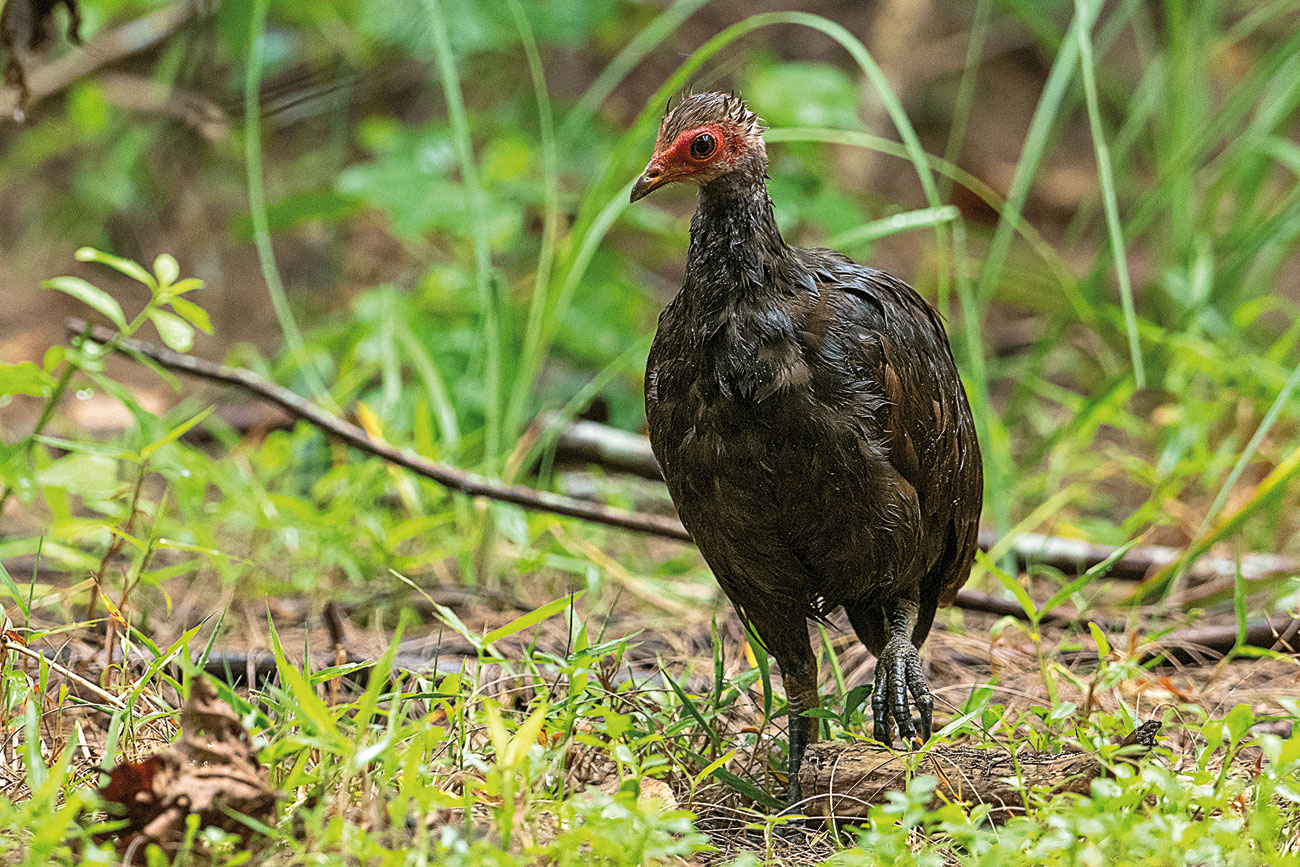
The Nicobar Megapode Megapodius nicobariensis is endemic to the Nicobar Islands. A shy and secretive bird, the megapode builds a mound using sandy soil and dry leaves to lay its eggs. The rotting vegetation provides the required incubation. Photo: Aseem Kothiala.
Uncovering Layers
As I became more familiar with the spots where a variety of birds congregated, I began noticing that some birds are more commonly seen than others. For example, the Pied Imperial Pigeon is found near settlements (revenue areas), and Glossy Starlings often occupy long, bare, and semi-submerged logs. This space is also shared by non-native birds, which were introduced to the island, such as the Blue Rock Pigeon, the Common Myna and the House Crow. It is deeply worrisome to spot them as they might outcompete native birds and become invasive. There are reports of House Crow sightings from as far south as Galathea Bay. Other commonly seen native birds around human settlements include the Common Hill Myna and the Nicobar Long-tailed Parakeet while the Nicobar Parakeet, the Black-naped Oriole and the Andaman Green Pigeon are seen along the forest edge. The latter are primarily found in lowland forests and their collective calls resemble a melodious orchestra. Yet, other birds are difficult to spot within the thick and dark vegetation. Once, I was able to hide behind a tall, bushy fern from where I sighted a little creature hopping under the shade of a tree. When light fell on it, I could see its emerald green body, brown head, and a crimson belly. I instantly knew it was the Hooded Pitta. Another time, while I walked through a forest trail within the Great Nicobar Biosphere Reserve, the rustling of dried leaves alerted an Emerald Dove that attempted a clumsy escape by flapping its wings and moments later, I saw its shadow drift across the forest.
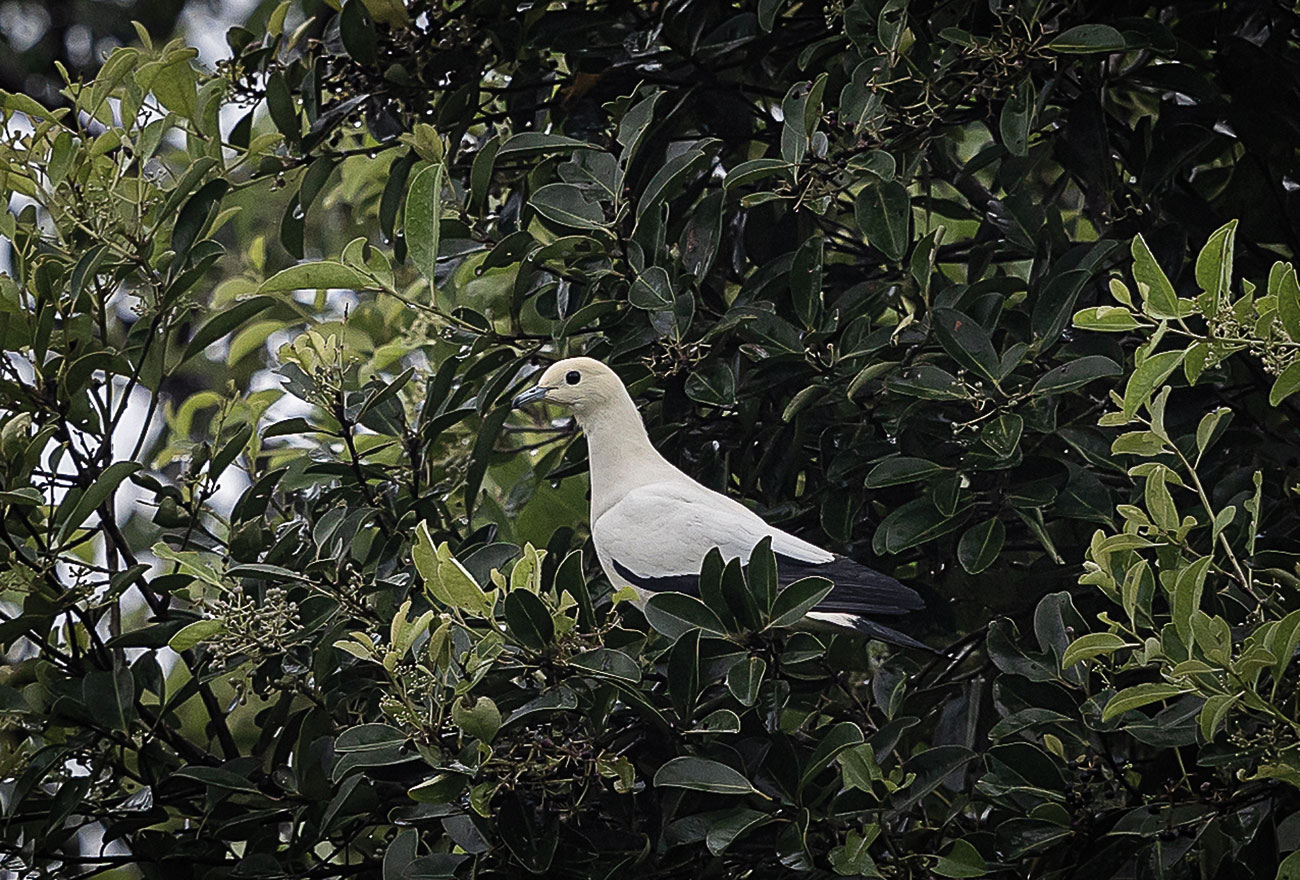
A large, black and white bird, the Pied Imperial Pigeon Ducula bicolour mostly inhabits coastal forests on offshore islands. In the Nicobar Islands, it is usually found near human settlements. Photo: Gobind Sagar Bhardwaj.
The south-eastern coast of Great Nicobar has a substantial number of wetlands over a single stretch. The area where the Campbell Bay wetland is situated is called Murdakhadi (which means ‘bay of the dead’), a name it gets from the graveyard situated next to it. The wetland is home to a large population of White Egrets and Pacific Reef Herons. Their mild howls are heard when the sea breeze blows through the littoral vegetation. Hundreds of migratory waterbirds and shorebirds can be found all across the wetlands situated in the villages of Govindnagar and Gandhinagar. In addition to the large congregations of plovers and sand pipers, a few individuals of the Terek Sandpiper, Oriental Pratincole, Sanderling, Ruddy Turnstone, Brown Noddy, Richard’s Pipit, and Lanceolated Warbler species can also be sighted.
As the sun sets and darkness envelops the island, the forest resonates with the calls of nocturnal creatures such as the Nicobar Scops Owl, Brown Boobook and Grey Nightjar. The Nicobar Scops Owl is highly territorial and with its habitat curtailed severely, only a handful of these can be found in the settlement area of Govindnagar. The Grey Nightjar is a winter visitor to the island and hard to spot until its distinctive call can be heard. When one is attentive, a continuous, electronic too-too-too-too sound… can be traced to this expert acrobat flying up and down in the paddy fields of Govindnagar.
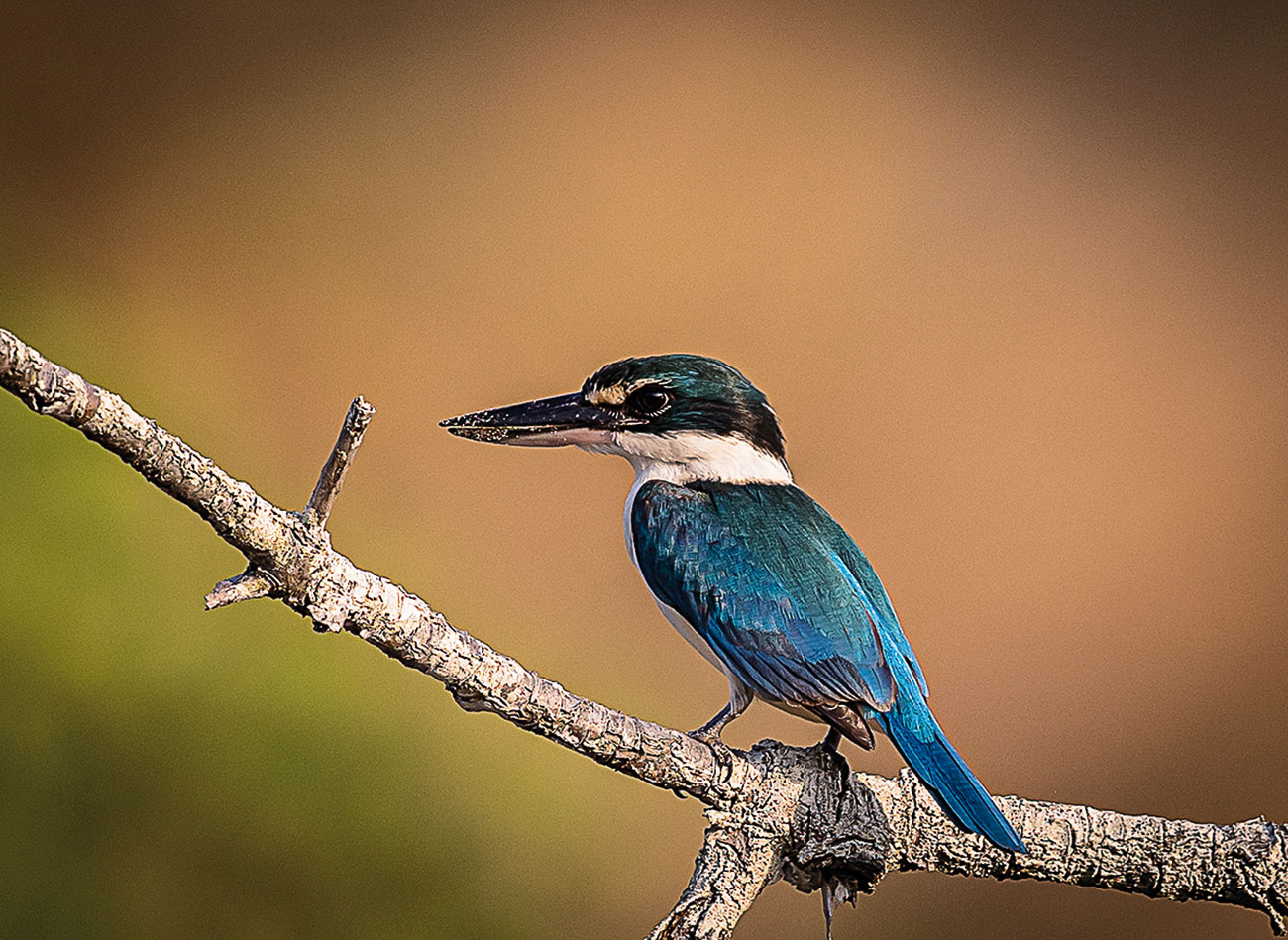
The White-collared Kingfisher Todiramphus chloris is a tree kingfisher of the subfamily Halcyoninae. Its preferred habitats range from coastal areas, particularly mangrove swamps, open woodland, grassland to farmlands and inland forests. Photo: Gobind Sagar Bhardwaj.
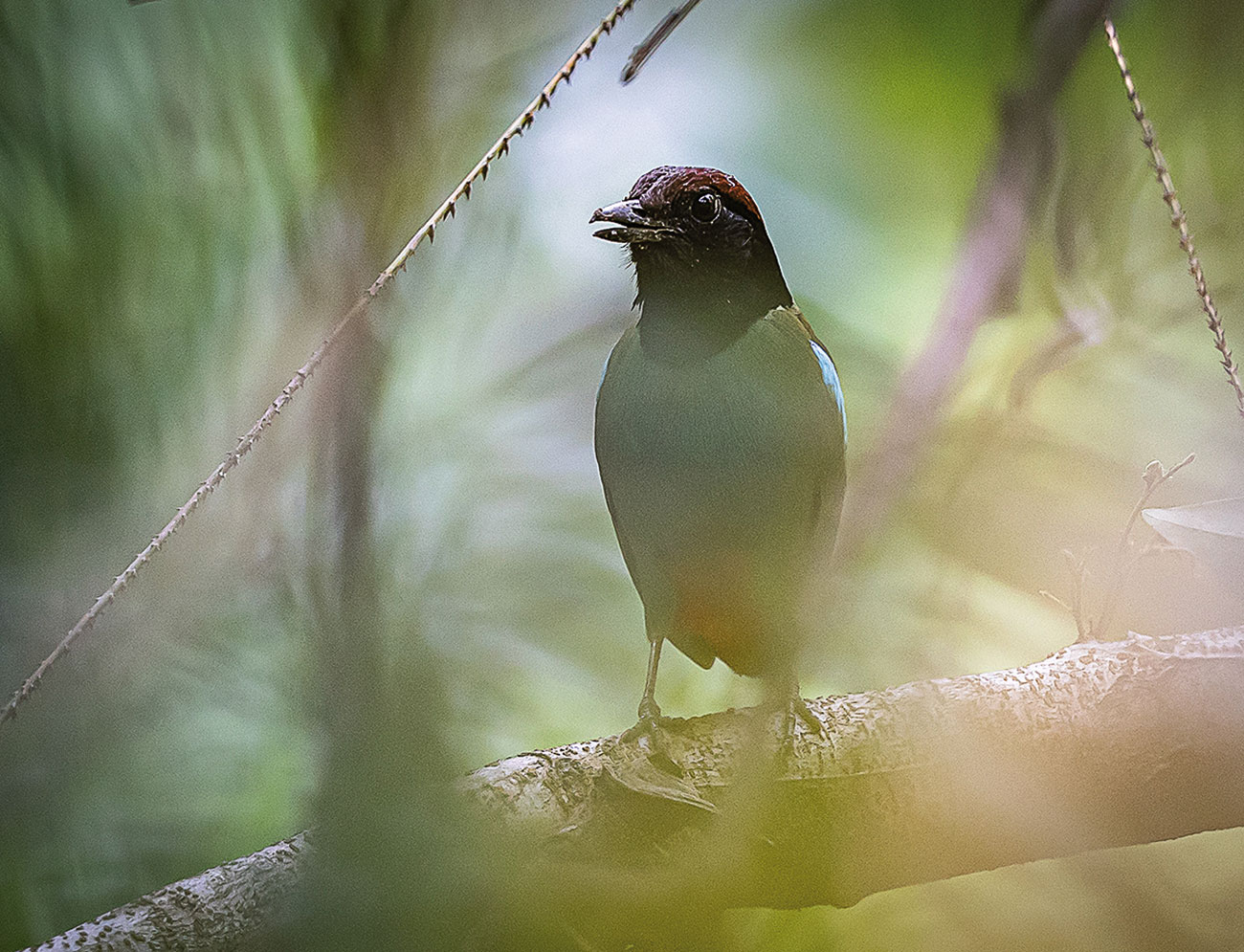
An emerald green bird, with a brown head, and a crimson belly, the Hooded Pitta (Nicobar) Pitta sordida abbotti shyly hops on the forest floor to forage for invertebrates. Currently, there are 12 recognised subspecies including the Nicobar subspecies. However, further research is required to understand species limits. Photo: Gobind Sagar Bhardwaj.
Avian Heritage
Great Nicobar, along with other Nicobar Islands, is part of the Sundaland Biodiversity Hotspot, one of only four Biodiversity Hotspots in India. Interestingly, the Andaman group of islands comes under the Indo-Burma Biodiversity Hotspot, indicative of the differences in the forest and the faunal assemblages between the two island groups, geologically separated by the 10-degree channel. Great Nicobar appears in the list of AZE (Alliance for Zero Extinction) sites and harbours areas such as Galathea Bay and Indira Point under the ‘Global Safety Net (2020)’, that if protected can ‘halt the dual crises of biodiversity loss and climate change’. The Nicobar Islands are also one among the 27 major Endemic Bird Areas (EBAs) in Asia. Great Nicobar is an Important Bird Area (IN451) that is classified under A1 (holding significant numbers of globally threatened species) and A2 (holding a significant population of at least two range-restricted species) categories.
Unsettling Birding News
On December 13, 2019, as I was sipping my tea in the evening, I noticed a large flock of Asian Openbill Storks gliding towards the islands. Two bird flyways pass over the island, the East Australasian Flyway (EAAF) and the Central Asian Flyway (CAF), which explains why the lush vegetation and the rich wetlands of Great Nicobar are a favourite resting spot for several migratory birds. On the following day, I was eager to catch a glimpse of the latest arrivals. As I packed my belongings, I received a call from a local journalist. He told me that hundreds of carcasses of these storks had been discovered along Gandhinagar’s coast, and more were washing up. I realised that the intense fire that had broken out in Indonesia’s palm plantations may have caused these fatalities. My excitement quickly turned into deep sorrow. Understanding the natural world in Great Nicobar often leaves one with a bitter-sweet feeling.
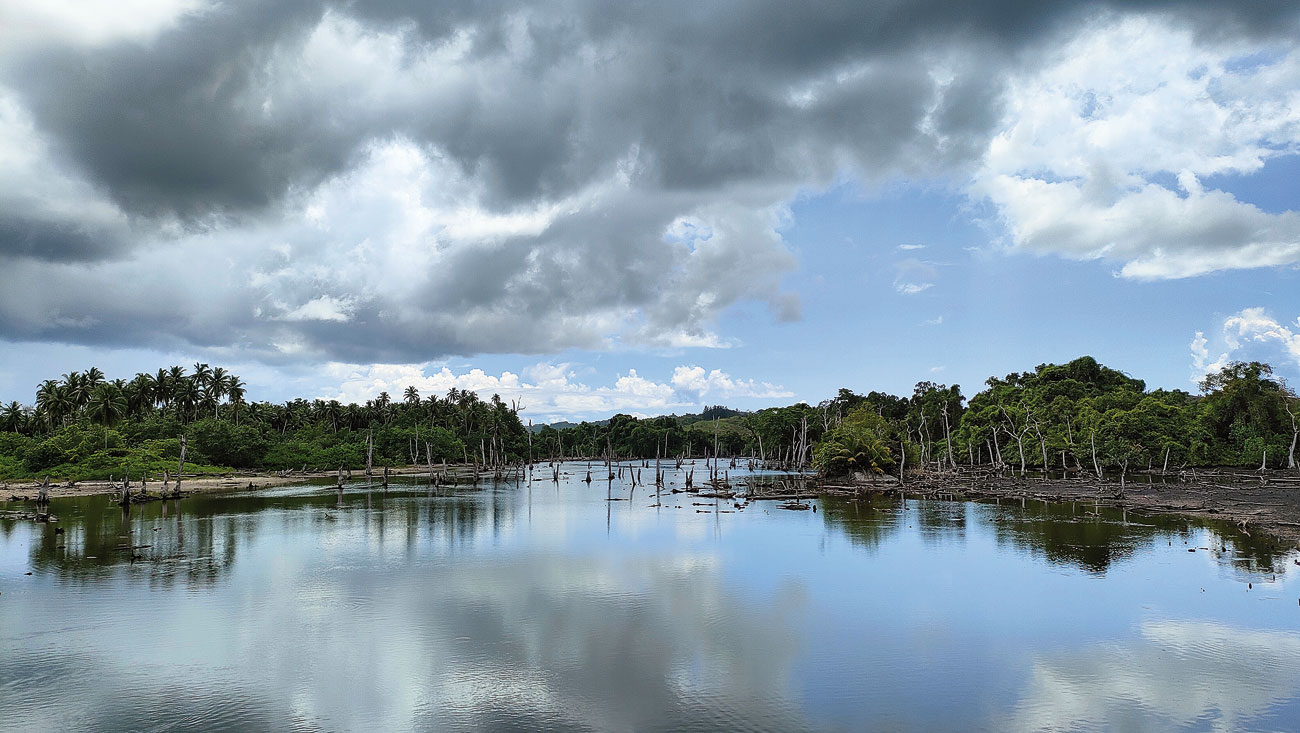
Several low-lying coastal settlements turned into wetlands post-tsunami in 2004, where the author has observed waders such as Lesser Sand Plovers Charadrius mongolus and Common Sandpipers Actitis hypoleucos seeking food. Photo: Sagar Rajpurkar.
Despite my long stay at Great Nicobar, and several well-planned birding trips, the Nicobar Megapode – the oldest genetic stock of the megapode family – has still eluded me. These mound-building birds are master architects – they use a mix of sandy soil and dry leaves to incubate their eggs. They often build mounds near old and decaying trees. Depending on mound depth, the journey of a hatchling from the bottom of the mound is slow (taking up to 3.5 days), precarious and deadly. Megapode calls are most frequently heard at dawn and dusk. During one such occasion, while on a survey at the Jogindernagar forest, I could even hear their echoing calls… kyouououou... kyououou... resonating through the forest. I continue to cherish memories of that expedition, walking tirelessly through the wet forest and being troubled by mosquitoes and leeches. As sought after and celebrated by the birdwatching community as it is, the Nicobar Megapode is also equally vulnerable. In 1997, there was an outbreak of avian cholera in the domestic fowl of Great Nicobar, the symptoms of which were also seen in the megapodes. The outbreak ended up killing over 50 per cent of the fowl. There is no record of what happened to the infected megapodes.
Diverse Ecosystems
The Andaman and Nicobar Islands are an archipelago consisting of about 572 islands in the Bay of Bengal, quite far (about 1,350 km.) from mainland India. With a landmass of 8,249 sq. km. and a coastline of 1,962 km., the islands stretch from the south of Myanmar to the north of Sumatra, representing diverse ecosystems found nowhere else on the planet. The evergreen and littoral forests, mangroves, marshy wetlands and fringing coral reefs are some of the critical ecosystems in the islands, which, when coupled with an undulating topography, heavy rainfall and a highly humid climate, make home for some of the most unique and incredible flora and fauna.
My desire to see the megapodes continues to remain strong, and I long to return to Great Nicobar. The recently denotified Galathea Bay Wildlife Sanctuary is still a hopeful location to spot this endangered bird, as their continuous calls echo through the area. However, there are justified concerns regarding the impacts of the megaprojects on the island, and I hope to visit before any major changes take place. My memory of birding on this island is like a constellation of stars in my imagination, with a vacant spot where the luminous moon should be – the Nicobar Megapode is that moon. With over 51 active megapode nests in the area of the now-approved megaproject, 30 of them will be permanently destroyed on account of construction activities. A sad realisation has engulfed me with anxiety that my vacant spot may never be filled.






